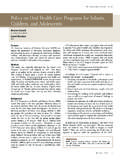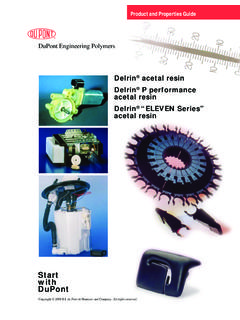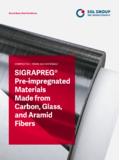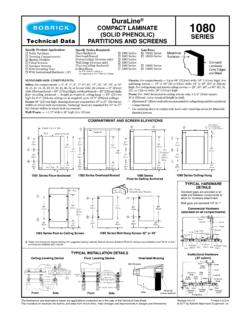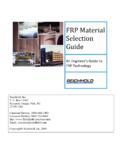Transcription of Guideline on Pediatric Restorative Dentistry
1 Official but Unformatted Guideline on Pediatric Restorative Dentistry Originating Committee Clinical Affairs Committee Restorative Dentistry Subcommittee Review Council Council on Clinical Affairs Adopted 1991. Revised 1998, 2001, 2004, 2008. Purpose The American Academy of Pediatric Dentistry (AAPD) presents this Guideline to assist the practitioner in the Restorative care of infants, children, adolescents, and persons with special health care needs. The objectives of Restorative treatment are to repair or limit the damage from caries, protect and preserve the tooth structure, reestablish adequate function, restore esthetics (where applicable), and provide ease in maintaining good oral hygiene.
2 Pulp vitality should be maintained whenever possible. Methods This document is an update of the Guideline last revised in 2007. This revision is based on current dental and medical literature related to Restorative Dentistry . An electronic search was conducted using PubMed with the following parameters: Terms: dental amalgam , dental composites , stainless steel crowns , glass ionomer cements", resin-modified glass ionomer cements", "dentin/enamel adhesives", "Bisphenol A", "resin infiltration", and dental sealants ; Fields: all fields; Limits: within the last 10 years, humans, English, clinical trials. Papers for review were chosen from the resultant list of articles and from references within selected articles.
3 When data did not appear sufficient or were inconclusive, recommendations were based upon expert and/or consensus opinion by experienced researchers and clinicians as well as consensus statements resulting from the expert literature review and evidence-based position papers presented at the 2002 AAPD Pediatric Restorative Dentistry Consensus Conference (Chicago, Ill).1. Background Restorative treatment is based upon the results of a clinical examination and is ideally part of a comprehensive treatment plan. The treatment plan shall take into consideration: 1. developmental status of the dentition;. 2. caries-risk assessment2,3;. 3. patient's oral hygiene.
4 4. anticipated parental compliance and likelihood of recall;. 5. patient's ability to cooperate for treatment. The Restorative treatment plan must be prepared in conjunction with an individually-tailored preventive program. Caries risk is greater for children who are poor, rural, or minority or who have limited access to Factors for high caries risk include decayed/missing/filled surfaces greater than the child's age, numerous white spot lesions, high levels of mutans streptococci, low socioeconomic status, high caries rate in siblings/parents, diet high in sugar, and/or presence of dental Studies have reported that maxillary primary anterior caries has a direct relationship with caries in primary molars6-8.
5 And caries in the primary dentition is highly predictive of caries occurring in the permanent Restoration of primary teeth differs from restoration of permanent teeth, due in part to the differences in tooth morphology. The mesiodistal diameter of a primary molar crown is greater than the cervicoocclusal dimension. The buccal and lingual surfaces converge toward the occlusal. The enamel and dentin are thinner. The cervical enamel rods slope occlusally, ending abruptly at the cervix rather than being oriented gingivally and gradually becoming thinner as in permanent The pulp chambers of primary teeth are proportionately larger and closer to the surface.
6 Primary teeth contact areas are broad and flattened rather than being a small distinct circular contact point, as in permanent teeth. Shorter clinical crown heights of primary teeth also affect the ability of these teeth to adequately support and retain intracoronal restorations. Young permanent teeth also exhibit characteristics that need to be considered in Restorative procedures, such as large pulp chambers and broad contact areas that are proximal to primary ,10. Tooth preparation should include the removal of caries or improperly developed or unsound tooth structure to establish appropriate outline, resistance, retention, and convenience form compatible with the Restorative material to be utilized.
7 Rubber-dam isolation should be utilized when possible during the preparation and placement of Restorative materials. As with all guidelines , it is expected that there will be exceptions to the recommendations based upon individual clinical findings. For example, stainless steel crowns (SSCs) are recommended for teeth having received pulp therapy. However, an amalgam or resin restoration could be utilized in a tooth having conservative pulpal access, sound lateral walls, and less than 2 years to Likewise, a conservative Class II restoration for a primary tooth could be expanded to include more surface area when the tooth is expected to exfoliate within 1 to 2 years.
8 Recommendations Dentin/enamel adhesives Dentin/enamel adhesives allow bonding of resin-based composites and compomers to primary and permanent teeth. Adhesives have been developed with reported dentin bond strengths exceeding that of In vitro studies have shown that enamel and dentin bond strength is similar for primary and permanent ,8,11-16 The clinical success of adhesives allows for more conservative preparation when using composite Restorative materials. Adhesive systems currently follow either a total-etch or a self-etch technique. Total etch technique requires 3 steps. It involves use of an etchant to prepare the enamel while opening the dentinal tubules, removing the smear layer, and decalcifying the dentin.
9 After rinsing the etchant, a primer is applied that penetrates the dentin, preparing it for the bonding agent. The enamel can be dried before placing the primer, but the dentin should remain moist. A bonding agent then is applied to the primed dentin. A simplified adhesive system that combines the primer and the adhesive is available. Because the adhesive systems require multiple steps, errors in any step can affect clinical success. Attention to proper technique for the specific adhesive system is critical to Recommendations: The dental literature supports the use of tooth bonding adhesives, when used according to the manufacturer's instruction unique for each product, as being effective in primary and permanent teeth in enhancing retention of restorations, minimizing microleakage, and reducing Bisphenol A and dental materials Bisphenol A (BPA) is widely used in the manufacturing of many consumer plastic products and can become part of dental sealants and composites in 3 ways.
10 As a direct ingredient, as a by-product of other ingredients in dental sealants and composites that may have degraded [eg. bisphenol A glycidyl methacrylate (bis-GMA) and bisphenol A dimethacrylate (bis-DMA)], and as a trace material left-over from the manufacturing of other ingredients used in dental sealants and The most significant window of potential exposure to BPA is immediately following the application of resin-based dental sealants and composites. Based on current evidence, the US Food and Drug Administration (FDA) and the American Dental Association (ADA) do not believe there is a basis for health concerns relative to BPA. exposure from any dental material and have concluded that any low-level of BPA exposure that may result from dental sealants and/or composites poses no known health ,20.



